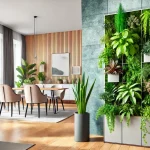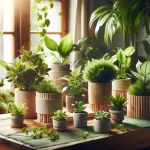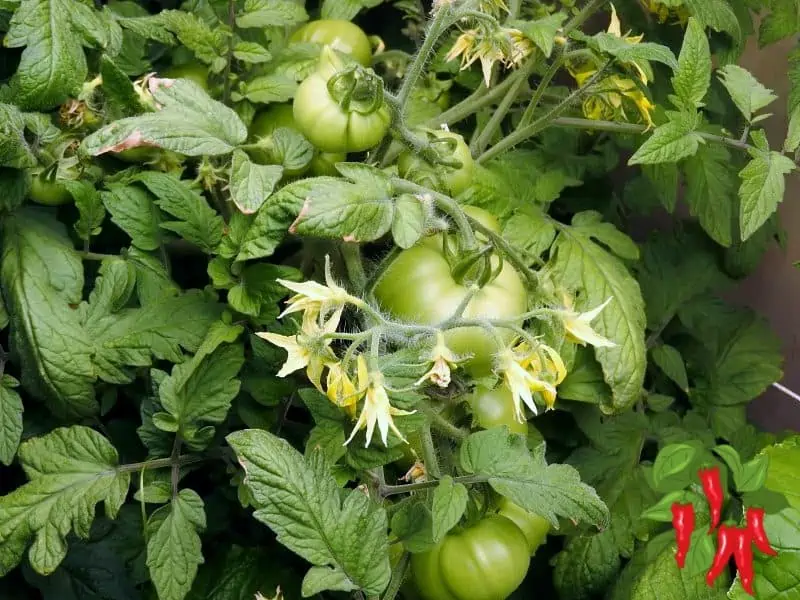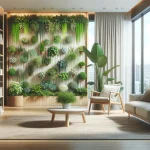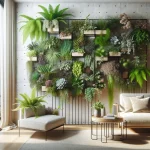This post may contain affiliate links. If you buy something from one of our links we may earn a commission. Thanks
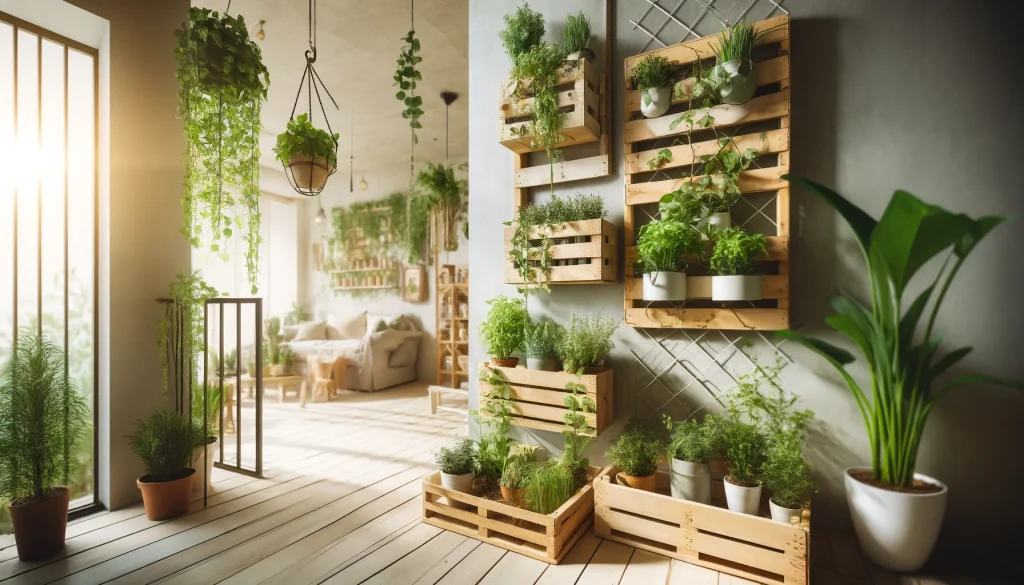
Are you struggling to find gardening space in your small apartment or balcony? Vertical garden ideas for small spaces might be just what you need.
Imagine transforming those tiny areas into lush, green havens with a few clever tricks. Let’s explore how you can do this easily and affordably!
Small Space Vertical Garden Ideas
Key Takeaways
- Vertical garden ideas for small spaces can transform your tiny apartment or balcony into a lush haven.
- Vertical gardens use small spaces by growing up rather than out
- Use pallet planters, hanging pots, and trellises to maximize space and add greenery effortlessly.
Vertical Garden Ideas for Small Spaces
Vertical gardening is all about growing your plants upwards instead of outwards. This method lets you make the most of your vertical space, perfect for small apartments and balconies.
Benefits of Vertical Gardening for Small Spaces
If you’re short on space, vertical gardening is a lifesaver. It allows you to use those vertical areas, like walls and railings, that usually go unused.
How Vertical Gardens Save Space
By growing plants up instead of spreading out, you save precious floor space. This is especially handy in city living where every square inch counts.
Adding Beauty to Your Home
Vertical gardens can turn a dull wall or a plain balcony into a beautiful, green oasis. They bring a bit of nature and color into your home, making it more inviting.
Improving Air Quality
Plants in vertical gardens can help clean the air by absorbing carbon dioxide and releasing oxygen. They also filter out pollutants, making your home a healthier place to live.
Vertical Garden Ideas for Small Spaces on a Budget
Pallet Planter
If you’re looking for a cheap DIY vertical garden, pallet planters are a great option. They are perfect for small spaces and easy on the wallet.
Pallets are often available for free or at a low cost from local businesses, hardware stores, or online marketplaces.
Benefits:
Using pallets for gardening is a smart way to recycle old materials and create a sturdy structure for your plants.
These planters can hold a variety of plants and are easy to set up. They’re perfect for growing herbs, small flowers, and succulents, adding both beauty and practicality to your space.
Tips on Where to Find Pallets and How to Set Them Up:
You can usually find pallets at local grocery stores, warehouses, or hardware stores. Sometimes, they even give them away for free.
When setting up your pallet planter, make sure to clean it thoroughly and check for any nails or rough edges.
Stand the pallet upright and secure it to a wall or fence. Fill the spaces with soil and plant your chosen herbs, flowers, or succulents. Water regularly, and you’re good to go!
Suitable Plants:
- Herbs (like basil, parsley, and mint)
- Small flowers (like marigolds and pansies)
- Succulents (like aloe and hens-and-chicks)
Recycled Plastic Bottles
Creating a vertical garden using recycled plastic bottles is not only eco-friendly but also very cost-effective. It’s a fantastic way to repurpose materials that would otherwise end up in the trash.
Step-by-Step Guide on Creating a Vertical Garden Using Plastic Bottles:
- Gather Your Materials: You’ll need a few empty plastic bottles, some strong twine or wire, a pair of scissors, soil, and your plants.
- Prepare the Bottles: Cut the bottles horizontally, creating an opening for your plants. Make small holes at the bottom for drainage.
- Assemble the Garden: Thread the twine or wire through the bottles to create a hanging structure. Securely attach each bottle, making sure they are evenly spaced.
- Plant Your Garden: Fill the bottles with soil and plant your herbs or small leafy greens. Hang your new vertical garden on a sunny wall or balcony railing.
- Maintain Your Garden: Water your plants regularly and make sure they get enough sunlight.
Eco-Friendly and Cost-Effective:
Using recycled bottles reduces waste and costs almost nothing. It’s an easy project that anyone can do, and it’s great for the environment.
Suitable Plants:
- Herbs (like cilantro, chives, and dill)
- Small leafy greens (like lettuce and spinach)
Low Maintenance Vertical Garden Ideas for Small Spaces
If you’re looking for easy, low-maintenance vertical garden ideas for small spaces, you’re in the right place.
These gardens need minimal care, making them perfect for busy folks or gardening newbies.
Let’s dive into how you can enjoy a lush, green space without all the fuss.
Succulent Shutters
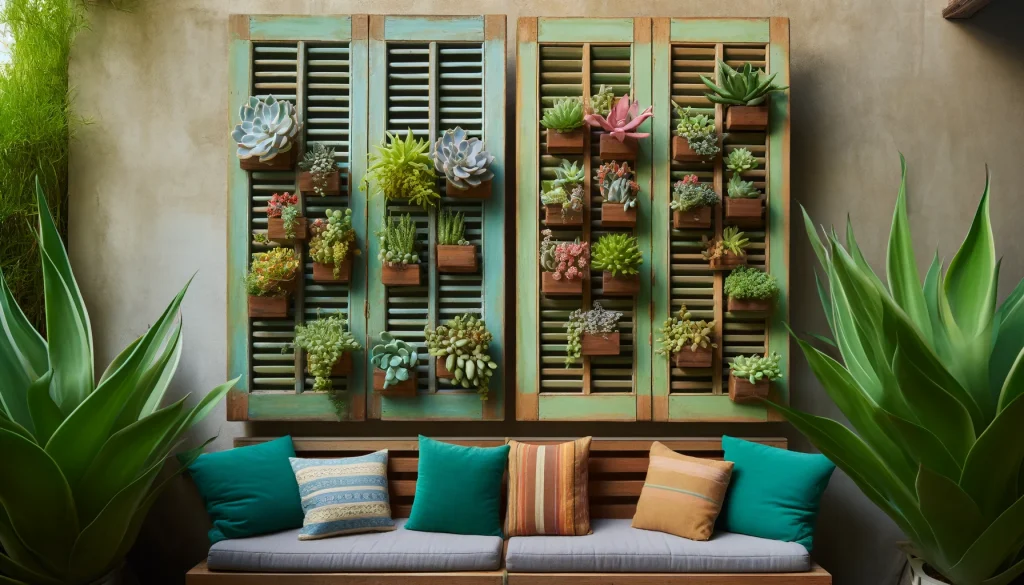
If you’re looking for easy, low-maintenance vertical garden ideas for small spaces, succulent shutters are perfect.
These gardens need minimal care, making them great for busy folks or gardening newbies.
Succulent shutters involve attaching small planters or pockets filled with soil to an old window shutter.
You can mount the shutter on a wall or fence, creating a striking vertical garden.
Setup Guide:
Succulent shutters involve attaching small planters or pockets filled with soil to an old window shutter.
You can mount the shutter on a wall or fence, creating a striking vertical garden.
To get started, you’ll need an old shutter, small pots or fabric pockets, soil, and various succulents.
- Prepare the Shutter: Clean and paint the shutter if needed. Make sure it is sturdy and ready for hanging.
- Attach the Planters: Securely attach the small pots or pockets to the shutter. You can use strong glue, nails, or screws.
- Plant the Succulents: Fill each planter with a well-draining soil mix and plant your succulents. Arrange them in a way that looks pleasing to you.
- Mount the Shutter: Hang the shutter on a sunny wall or fence. Ensure it is secure and stable.
- Maintain the Garden: Water the succulents sparingly, as they don’t need much water. Check them occasionally for any signs of pests or disease.
Low Water and Maintenance Needs:
Succulents are perfect for low-maintenance gardens because they require very little water and thrive in various conditions.
Just give them some sunlight and occasional watering, and they’ll be happy.
Suitable Plants:
- Echeveria
- Aloe Vera
- Hens-and-Chicks
- Jade Plant
Living Wall Fence
A living wall fence is a fantastic way to create a green, natural barrier that requires minimal upkeep.
These vertical gardens use slow-growing plants that need little attention, making them perfect for busy gardeners.
Living Wall Benefits:
A living wall fence involves growing plants directly on a fence or creating a freestanding structure that supports the plants.
These walls add greenery and privacy but also help insulate your space and reduce noise. They are ideal for small balconies and patios.
Easy Maintenance with Slow-Growing Plants: Living walls made with slow-growing plants are easy to maintain.
These plants don’t require frequent trimming or extensive care, making them ideal for people who want a beautiful garden without a lot of work.
Suitable Plants:
- Ferns
- Ivy
- Moss
Setup Guide:
- Choose Your Structure: Decide whether you’ll be using an existing fence or building a new structure. Ensure it is strong enough to support the weight of the plants.
- Prepare the Wall: Attach a sturdy framework, such as a trellis or wire mesh, to the fence. This will hold your plants in place.
- Plant Your Wall: Select slow-growing plants that suit your climate. Plant them in soil-filled pockets or attach them directly to the framework.
- Water and Maintain: Water the plants regularly, but not excessively. Slow-growing plants won’t need much trimming, so just keep an eye on their health.
Vertical Garden Ideas for Small Balconies
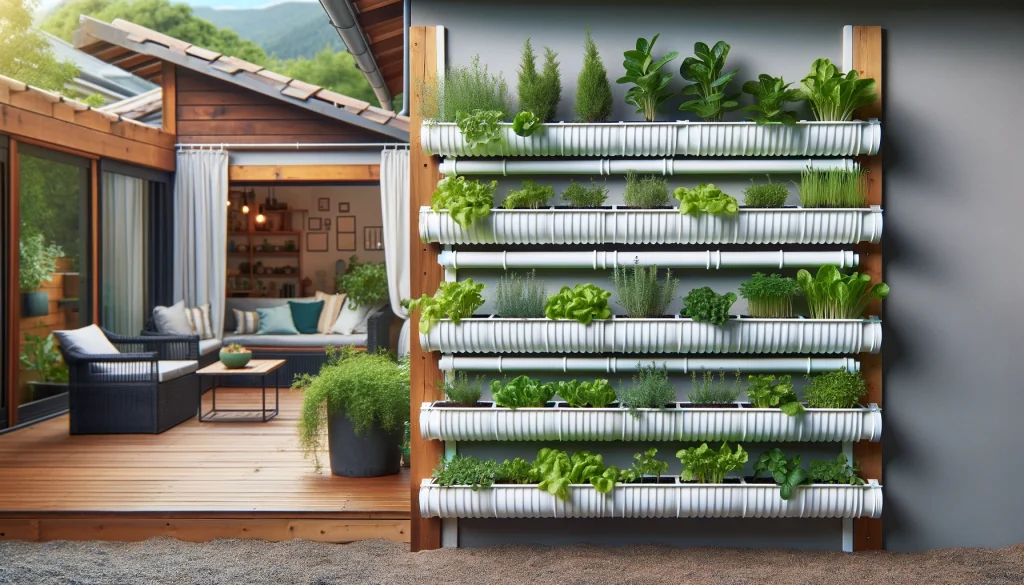
If you’ve got a small balcony and think you can’t have a garden, think again! Vertical garden design ideas for small balconies are here to save the day.
With a bit of creativity, you can transform that tiny space into a lush, green oasis. Let’s dive into some fun and easy ideas!
Gutter Garden
A gutter garden is an excellent way to maximize vertical space on a small balcony. It’s simple to set up and perfect for growing a variety of plants. Here’s how you can install and maintain a gutter garden:
How to Install and Maintain a Gutter Garden:
- Gather Materials: You’ll need some old gutters, brackets, screws, a drill, soil, and your plants. You can also buy new gutters at a home improvement store.
- Cut the Gutters: Cut the gutters to fit your desired length. Make sure they will fit comfortably on your balcony wall.
- Attach Brackets: Secure the brackets to your balcony wall where you want to place the gutters.
- Install Gutters: Attach the gutters to the brackets securely.
- Add Drainage Holes: Drill small holes in the bottom of the gutters for drainage.
- Fill with Soil: Fill the gutters with a good quality potting mix.
- Plant Your Garden: Plant your chosen strawberries, herbs, or small flowers in the soil. Water them thoroughly.
Maintenance:
- Watering: Regularly check the soil moisture and water as needed. Gutter gardens can dry out quickly.
- Fertilizing: Use a balanced liquid fertilizer every few weeks to keep your plants healthy.
- Pruning: Remove any dead or yellowing leaves to keep your garden looking tidy.
Benefits for Small Balconies:
Gutter gardens are perfect for small balconies because they use vertical space efficiently. They keep plants off the ground, which can help reduce pests and make watering easier. Plus, they add a unique, modern look to your outdoor space.
Suitable Plants:
- Strawberries
- Herbs (such as basil, mint, and thyme)
- Small flowers (like marigolds and petunias)
Hanging Baskets
Self Watering Hanging Planters Indoor Flower Pots
Hanging baskets are a fantastic way to add greenery to your balcony without taking up floor space. They’re versatile, easy to maintain, and can hold a variety of plants.
Different Types of Hanging Baskets and Their Benefits:
- Wire Baskets with Coco Liners: These are great for good drainage and air circulation. They’re perfect for flowers and trailing plants.
- Plastic Hanging Pots: These are lightweight and retain moisture well, making them ideal for herbs and small vegetables.
- Fabric Hanging Bags: These are versatile and can be attached to walls or railings. They’re great for growing herbs and flowers.
Hanging Basket Benefits:
- Space-Saving: Hanging baskets free up floor space, making them perfect for small balconies.
- Aesthetic Appeal: They add vertical interest and beauty to your balcony.
- Versatility: You can move them around easily and change plants seasonally.
Suitable Plants:
- Trailing Flowers (like petunias, ivy geraniums, and nasturtiums)
- Herbs (such as parsley, cilantro, and oregano)
- Small Vegetables (like cherry tomatoes and lettuce)
Vertical Gardening Systems
Thinking about going vertical with your garden? Vertical gardening systems like hydroponic living walls and tower gardens are fantastic ways to grow more in less space.
Read more: Best Plants for Vertical Gardening: 10 Vertical Garden Tips – Stay Green Garden
These systems are efficient, easy to maintain, and perfect for any indoor or small outdoor area. Let’s dive into the details!
Hydroponic Living Walls
36 Pockets Self Watering Vertical Planters Indoor Outdoor Living Wall Mounted
Hydroponic living walls are a game-changer for anyone looking to grow plants without soil.
This method uses nutrient-rich water to feed the plants, making it super efficient and clean. Plus, it’s perfect for vertical gardening systems.
Hydroponics and Its Benefits:
Hydroponics is a method of growing plants using water mixed with essential nutrients, instead of soil.
This system allows plants to grow faster and healthier because they have direct access to nutrients.
Read more about indoor vertical hydroponics.
Benefits include less water usage, faster plant growth, and the ability to grow plants indoors or in small spaces.
How to Set Up a Hydroponic System at Home:
- Gather Materials: You’ll need a hydroponic system kit (or build your own with PVC pipes, a water pump, and a reservoir), a grow light if you’re indoors, a nutrient solution, and your plants.
- Assemble the System: Follow the instructions for your kit, or assemble your DIY setup. Ensure the water pump is set up to circulate the nutrient solution through the system.
- Add the Nutrient Solution: Fill the reservoir with water and add the nutrient solution according to the instructions.
- Plant Your Seedlings: Place your seedlings in the net pots or grow cups that are part of the hydroponic system.
- Maintain the System: Regularly check the water levels, nutrient concentration, and pH levels. Make sure your plants are getting enough light.
Suitable Plants:
- Leafy Greens (like lettuce, spinach, and kale)
- Herbs (such as basil, mint, and cilantro)
- Strawberries
Tower Gardens
Tower Garden Hydroponics Growing System,Indoor Smart Garden
Tower gardens are another fantastic vertical gardening system that lets you grow a ton of plants in a small footprint.
They’re basically vertical towers filled with plant slots, perfect for growing a variety of plants.
Tower Garden Advantages:
Tower gardens use a vertical structure to hold multiple plant slots, allowing you to grow dozens of plants in a small space.
They often use hydroponics or aeroponics (which uses mist instead of water) to feed the plants. The advantages are huge: you get high yields, save space, and they’re pretty low maintenance once set up.
Suitable Plants:
- Vegetables (like tomatoes, peppers, and cucumbers)
- Herbs (such as parsley, rosemary, and thyme)
- Small Fruits (like strawberries and dwarf berries)
DIY Indoor Vertical Garden
If you’re itching to grow some plants but don’t have much space, DIY indoor vertical gardens are the perfect solution.
You can transform any wall into a lush green space with just a little creativity. Let’s explore some fun and easy ways to create your own indoor vertical garden.
DIY Wall Garden
Creating a DIY wall garden indoors is a fantastic way to bring nature inside without taking up any floor space.
It’s perfect for growing herbs or small decorative plants, and it adds a beautiful, green touch to your home.
Step-by-Step Guide to Creating a Wall Garden Indoors:
- Gather Materials: You’ll need a sturdy frame or trellis, pots or planters, wall hooks, soil, and your plants.
- Prepare the Wall: Choose a wall that gets enough light for your plants. Use wall hooks to securely attach the frame or trellis to the wall.
- Attach Planters: Securely hang the pots or planters on the frame. Make sure they are evenly spaced and stable.
- Fill with Soil: Fill each planter with a high-quality potting mix.
- Plant Your Garden: Plant your chosen herbs or small decorative plants in the pots. Water them thoroughly.
- Maintain Your Garden: Regularly water your plants and check for any signs of pests or diseases. Rotate plants if needed to ensure they all get enough light.
Suitable Plants:
- Herbs (like basil, parsley, and chives)
- Small Decorative Plants (such as succulents and ferns)
Shoe Hanger Garden
A shoe hanger garden is an innovative and super easy way to grow plants indoors. Using an old shoe organizer, you can create a vertical garden that’s perfect for herbs and small leafy greens.
Innovative Use of Shoe Organizers for Indoor Gardening:
- Gather Materials: You’ll need a fabric or plastic shoe organizer, soil, and your plants.
- Prepare the Organizer: Make sure the shoe organizer is clean and has drainage holes. If it doesn’t, you can poke small holes in the bottom of each pocket.
- Hang the Organizer: Find a sunny spot in your home and hang the shoe organizer on a wall or door.
- Fill with Soil: Fill each pocket with potting mix.
- Plant Your Garden: Plant your herbs or small leafy greens in each pocket. Water them well.
- Maintain Your Garden: Water your plants regularly and ensure they get enough light. Rotate the organizer if necessary to give all plants equal light.
Suitable Plants:
- Herbs (like mint, oregano, and thyme)
- Small Leafy Greens (such as lettuce and spinach)
Small Vertical Garden
If you’re short on space but still want a garden, small vertical gardens are the way to go.
They let you grow plenty of plants in a compact area, making the most of your available space. Let’s explore some creative design ideas to set up your own small vertical garden.
Ladder Planter Garden
Flower Holder Ladder Plant Rack
Repurposing an old ladder for vertical gardening is both practical and stylish. It’s a great way to grow a variety of plants in a small area, and it adds a unique touch to your garden setup.
How to Repurpose a Ladder for Vertical Gardening:
- Find an Old Ladder: Look for a sturdy, old wooden or metal ladder. If it needs a bit of TLC, sand it down and give it a fresh coat of paint.
- Set Up the Ladder: Place the ladder in a sunny spot where it won’t be in the way.
- Add Planters: Secure pots or planters on each step of the ladder. You can use brackets, hooks, or just place them directly on the steps.
- Plant Your Garden: Fill the pots with soil and plant your chosen herbs, flowers, or small vegetables. Water them well.
- Maintain Your Garden: Regularly water your plants and check for pests. Rotate the plants if needed to ensure they all get enough sunlight.
Suitable Plants:
- Herbs (like basil, thyme, and rosemary)
- Flowers (such as marigolds and petunias)
- Small Vegetables (like cherry tomatoes and peppers)
Hanging Pots
Hanging Planters, Large Hanging Planter with Drain Holes
Hanging pots are an excellent way to maximize your vertical space and add some greenery to your home.
They’re perfect for trailing plants, herbs, and small flowers, making your space look vibrant and lush.
Ideas for Using Hanging Pots to Maximize Space:
- Choose Your Pots: Select lightweight pots that are suitable for hanging. Make sure they have drainage holes.
- Find Hanging Spots: Identify spots where you can hang your pots, such as windows, walls, or ceiling hooks. Make sure these spots get enough light for your plants.
- Hang the Pots: Use strong hooks or brackets to securely hang your pots. Ensure they are stable and won’t fall.
- Plant Your Garden: Fill the pots with soil and plant your trailing plants, herbs, or small flowers. Water them thoroughly.
- Maintain Your Garden: Water your hanging plants regularly and ensure they get enough light. Rotate the pots if needed to give all plants equal light.
Suitable Plants:
- Trailing Plants (like ivy, pothos, and string of pearls)
- Herbs (such as mint, parsley, and cilantro)
- Small Flowers (like fuchsias and begonias)
Vertical Garden Ideas for Small Spaces FAQs
Got questions about vertical gardening? You’re not alone! Here are some of the most common questions folks have about setting up and maintaining a vertical garden in small spaces. Let’s dive in and get those questions answered.
Q. How do you vertically garden in small spaces?
A. Vertical gardening in small spaces involves using walls, fences, or other vertical surfaces to grow plants.
Use shelves, hanging pots, or trellises to maximize your space. Start with easy-to-grow plants like herbs or small flowers and make sure they get enough light and water.
Q. What is the cheapest way to make a vertical garden?
A. One of the most budget-friendly ways to create a vertical garden is by using pallet planters or recycled plastic bottles.
Pallets can often be found for free at local stores, and old plastic bottles make great planters. Both options are eco-friendly and easy on the wallet.
Q. What plants are good for vertical gardening?
A. Many plants thrive in vertical gardens. Some great options include:
- Herbs (basil, mint, parsley)
- Leafy greens (lettuce, spinach)
- Flowers (marigolds, petunias)
- Vining plants (ivy, pothos)
- Small vegetables (cherry tomatoes, peppers)
Q. Are there any drawbacks to using vertical gardens?
A. While vertical gardens are fantastic, there are a few potential drawbacks. They can dry out more quickly than traditional gardens, so you need to water them regularly.
Also, some plants may need additional support to grow vertically. Choosing the right plants and maintaining them properly can help mitigate these issues.
Q. What plants are not suitable for vertical farming?
A. Some plants don’t do well in vertical setups, including:
- Large root vegetables (carrots, potatoes)
- Tall, heavy plants (corn, large tomato varieties)
- Plants that need a lot of horizontal space (squash, melons)
Q. What are three types of vertical gardens?
A. There are several types of vertical gardens you can try:
- Hydroponic Systems: These use nutrient-rich water instead of soil and are great for growing leafy greens and herbs.
- Living Walls: These are made up of panels of plants that grow vertically, perfect for adding greenery to walls and fences.
- Pallet Planters: These are simple to set up using wooden pallets, ideal for herbs, small flowers, and succulents.
Vertical Garden Ideas Conclusion
Vertical gardening is a fantastic way to bring greenery into small spaces, whether you’re in an apartment or have a tiny balcony. With a bit of creativity and the right setup, you can grow a variety of plants and enjoy the many benefits of having a lush, green space.
Read more: Indoor Vertical Gardening: Start Your Indoor Garden Now
Recap of Benefits and Ideas
Vertical gardening offers numerous benefits, including maximizing space, improving air quality, and adding beauty to your home.
From gutter gardens and hanging baskets to hydroponic living walls and tower gardens, there are plenty of ways to create your own vertical garden.
These setups are space-efficient and also easy to maintain, making them perfect for anyone looking to add a touch of nature to their living space.
Encouragement to Start Your Vertical Garden
Don’t let limited space stop you from enjoying the joys of gardening. With the ideas and tips provided, you can start your own vertical garden and transform even the smallest area into a vibrant, green oasis.
Whether you choose to grow herbs, flowers, or vegetables, the possibilities are endless. Give it a try and see how rewarding vertical gardening can be!
Key Takeaways
- Maximize Space: Vertical gardening is perfect for small areas, making the most of vertical surfaces.
- Improve Air Quality: Plants help purify the air, creating a healthier living environment.
- Add Beauty: Vertical gardens add a touch of nature and color to your home.
- Easy Maintenance: Many vertical garden setups are low-maintenance and perfect for busy lifestyles.
- Variety of Options: From gutter gardens to hydroponic systems, there are many ways to create a vertical garden.
Visit my Amazon Influencer Page for videos and gardening products Grow Your Own Garden






